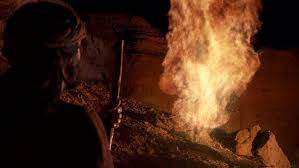After Leaving Succoth they Camped at Etham
13: 20-22
After leaving Succoth they came to Etham DIG: With what resources (human, natural and divine) did God lead the people out of Egypt? Which ones were easier than the others to follow?
REFLECT: How does God lead you through your wilderness wanderings?
The Sh’khinah glory is the visible manifestation of God’s presence, which is seen in the form of a light, fire, smoke, cloud, or combination of these. The Sh’khinah glory serves a number of different functions in the book of Exodus. The first function was to call Moses to become the redeemer of Isra’el (3:2), and now the second function was to lead Isra’el into the wilderness by day and by night. From the very beginning of their journey, the glory of ADONAI, was among them. Later this glory was designated as the Sh’khinah (16:10; 40:34). The presence of this pillar must have been a source of comfort and assurance to those who moved in anxiety, not sure of the events of the future.251
After leaving Succoth, the people camped at Etham on the edge of the desert (13:20). The exact location of Succoth is unknown, but the word is Egyptian and means fortress wall. At last they were at the edge of freedom, arriving at the final outpost before escaping into the wilderness. Nothing, it appears, was standing in the way of their deliverance.

Supernaturally guided by a pillar of cloud in the daytime, which became a pillar of fire at night, the Israelites apparently traveled some distance every day. By day ADONAI went ahead of them in a pillar of cloud to guide them on their way and by night in a pillar of fire to give them light, so that they could travel by day or night (13:21). It seems that the Israelites traveled some part of each day and each night, which would coincide with the modern practice. They probably traveled before the heat of the day became too severe and tried to utilize the cool of the evening. Besides guiding them, the cloud symbolized God’s presence, assuring them of His goodness and faithfulness.252
Neither the pillar of cloud by day nor the pillar of fire by night left its place in front of the people (13:22). God often spoke to the people from the pillar (Numbers 12:5-6; Deuteronomy 31:15-16; Psalm 99:6-7, 105:39). A similar cloud came to represent the glory of God in the Sanctuary throughout much of Isra’el’s history (Exodus 40:34-35; First Kings 8:10-11; Isaiah 4:5, 6:3-4). Our God never leaves His people without the guidance they need.253
The fire in the pillar of cloud was the same fire in which God revealed Himself to Moses from the burning bush (3:1-22), and afterwards descended upon Mount Sinai in the middle of thunder and lightning in a thick cloud (19:16-18). This cloud protected Isra’el from the heat of the day, sunstroke and pestilence (Isaiah 4:5-6, 49:10; Psalm 91:5-6), and by night lighted up her path and defended her from all harm (Psalm 27:1; Numbers 16:35). If necessary, God would send out a devouring fire, which would consume her enemies (Leviticus 10:2; Numbers 16:35). Therefore, the Sh’khinah glory, or the very presence of God, did not depart from them for the forty years they were in the desert and was a constant reminder of His guidance and His presence.
Not even the Church has the visible presence of God with it. The Bible tells us: Praise be to ADONAI, Father of our Lord Jesus Christ, who in the Messiah, has blessed us with every spiritual blessing in heaven (Ephesians 1:3). Moses and the nation of Isra’el in the desert, looked forward to the coming of the Messiah, or Christ, and today we look back on the First Coming as a historical event. We do not need the visible presence of God in order to walk by faith. They needed the Glory because the redemption had not yet been worked out in history as it has now.254 God had made every preparation for Moses and the nation of Isra’el to get through their desert, and for you and me to get through our desert.
Today, God offers direction through His Word and the promptings of the Ruach ha-Kodesh. This is a reality on which we must reflect. Yeshua made it clear: I am with you always, to the end of the age (Matthew 28:20). The writer to the Hebrews reminds us of what ADONAI said: Never will I leave you; never will I forsake you (Hebrews 13:5). Therefore, we can say with confidence, “ADONAI is my helper; I will not be afraid – what can mere mortals do to me” (Hebrews 13:6)? Jesus Christ is the same yesterday and today and forever (Hebrews 13:8). This is vital to the Spirit’s daily comfort in our lives.
In this sense, we must – like the Israelites – wait and listen for ADONAI. You can almost imagine the Israelites in their camp. They were satisfied but never fully settled. They set up camp but were always ready at any moment to move ahead. At any moment, God’s presence, like the cloud, would arise and press on. And Isra’el would follow. It is always wise to patiently and prayerfully look around and see what God is doing and join Him in His work.



Leave A Comment